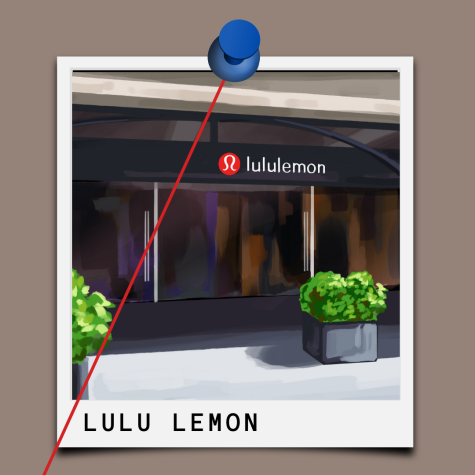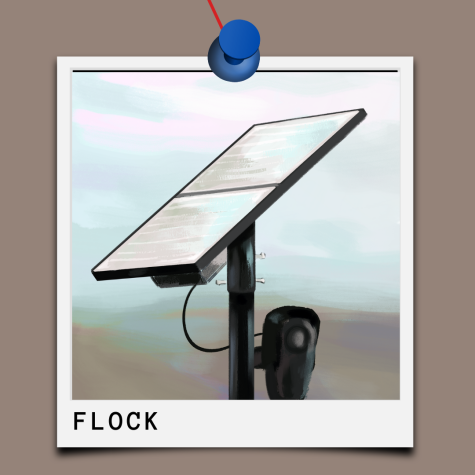Increasing theft in California prompts safety concerns and legal backlash
Examining the community reaction to different levels of theft in the state
February 12, 2022

In the past six months, reports of theft have surged throughout California, impacting residents statewide and prompting political backlash and safety concerns.
The alarms are most prominently sounded in the form of organized retail theft. On Nov. 20, 2021, 80 people jointly ransacked a Nordstrom, blocking off the streets with their license plate covered cars. In the same week and in the same fashion, a Louis Vuitton located in San Francisco’s Union Square was targeted. This surge has also spilled into Santa Clara County, affecting the shopping venue Santana Row, where a group entered and robbed a Lululemon while their alleged conspirators stole from a Sunglasses Hut in the nearby mall.
These increases in both low-scale and high-scale thefts have led critics to turn their worries towards California legal measures, more specifically Proposition 47 and California bail reform.
Low-scale theft
Since the start of his patrol in 2015, school resource officer of the Santa Clara County Police Department Aalok Patel noticed a general rise in low-scale theft, a trend that was disrupted in the pandemic due to the lack of commercial activity. Before the pandemic, Patel said it was common for the department to receive two to three calls related to shoplifting every week and to get anywhere from five to 15 vehicle break-ins in a day — this is due to the mobility burglars have when moving from parking lot to parking lot, allowing them to break into multiple cars and move on, which the police call a game of “catch-up.”
As the county recovers from COVID-19, Patel notes that this trend is increasing again. He believes this is because the burglars are making up for the money they lost during the pandemic. Patel hasn’t seen the numbers as parallel to pre-pandemic levels yet but “it’s significantly coming back” at a rapid pace, especially with vehicle break-ins.
Sophomore Harshitha Nandula has also noticed the increase in low-scale theft in her neighborhood, ranging from bike theft to vehicle break-ins. She has heard of at least five separate instances where her neighbor’s bikes were stolen — some out of their own backyards. Her bag was stolen last year, and in one instance, even her little sister’s shoes were taken too. Although the crimes are low-scale, Nandula believes these crimes have an impact on her lifestyle.
“Every single night, I have this weird type of anxiety to check [if] all the doors and windows are locked, even if my parents already checked it,” Nandula said.
One factor that Patel attributes to high rates of retail theft is what he sees as the liability cost to retailers. He describes how big retail chains would rather “take the loss of their merchandise than to hire an armed security guard and have something happen to the person stealing it.” When handling shoplifters, some companies have policies which don’t allow employees to stop them, but rather to wait and then call the police.
However, Patel and other state residents mainly attribute the general increase in low-scale crime to Proposition 47, a criminal reform act that was passed in 2014. The proposition aims to decrease incarceration rates in the state by reclassifying certain felonies as misdemeanors, including non-violent theft and drug possession offenses — non-violent theft up to $950 (up from $400) and possession of drugs for personal use are now considered misdemeanors instead of felonies. The proposition also allows those who were serving sentences for reclassified offenses to petition for resentencing and those who already served to petition for an amendment to their criminal record.
A study by the Public Policy Institute of California conducted in 2016 estimated a “50% decline in the number of individuals being held or serving sentences for Proposition 47 offenses. This change drove an overall decline in the jail population of 9% in the year following the proposition’s passage.”
As Patel puts it, “if you go inside a grocery store and you steal less than $950 worth of groceries and you get caught, then it would be considered to be a misdemeanor” rather than a felony. He says that people who are arrested will most likely be released anywhere from six to 12 hours and given a court date either on bail, Supervised Own Recognizance Program or their own recognizance. On the court date, if pleading guilty, a judge will determine the criminal’s sentencing based on the prosecution and defenses’ recommendations and previous criminal records. Since they’re classified as misdemeanors, these sentences usually range from probation to restitution, releasing the person back into society.
Due to the proposition and the reclassification of certain crimes, Patel believes the consequences are more “nonchalant” and that criminals continuously get released “so easily” into society which encourages them to continue because at the end of the day, they know they won’t go to prison.
“It’s becoming more and more prevalent to everybody saying ‘Hey, my car got broken into, my car got broken into, my car got broken into,’” Patel said. “People are becoming much more aware about what’s going on and people are realizing, ‘Hey, this is not okay. Why are people not being held accountable?’”
However, Santa Clara County District Attorney Jeff Rosen maintains that there are other factors involved in low-level crimes that the community doesn’t fully understand and that people shouldn’t form a causal statement. He has also seen property crime decrease in the last few years despite Proposition 47 being passed.
Rosen was one of the only two elected attorneys who approved of the proposition. A felony conviction stays on one’s record for a long period of time, which he believes makes it harder for them to reintegrate back into society — to Rosen, these people “are not felons” and that the crime is disproportionate to the punishment. Low-level crimes covered under Proposition 47 were also disproportionately brought against Blacks and Latinos, keeping them in jail for long periods of time. Additionally, Proposition 47 raised the dollar value up to $950 from $400, a number that hadn’t been changed for 20 years and was lagging behind inflation. Other states in the U.S. have also set higher thresholds for felony: Texas and South Carolina’s are $2,500 and most states set it at $1,000.
Robert Wood, a social advocate for Dream Corps, which is an organization that focuses on criminal justice reform, believes Proposition 47 helped increase equity and fairness. He argues that those who commit low level theft shouldn’t be put in prison with convicts who have committed serious crimes and that this allows younger people who engage in petty theft to redefine their lives.
In regards to theft, Rosen argues that the focus should be directed on catching criminals rather than the punishment they receive.
“If criminals understand that they’re likely to be caught if they commit a certain crime, that’s going to make them less likely to do it,” Rosen said. “That’s where I think we need to focus our attention [on] is catching individuals and prosecuting them. Whether the crime they’re charged with has an F for felony or an M for misdemeanor after it is not as important as the fact that they’ve been arrested, prosecuted and convicted for the crime.”
High-scale theft
Not only are low-scale crimes increasing, but recently, larger scale retail theft has also spilled into Santa Clara County. A Lululemon in Santana Row was robbed on Nov. 21 by a group of four — two women and two men, with one of the suspects seen with a firearm — stealing $40,000 worth of merchandise. Nearby, at the same time, a robbery was developing at the Sunglass Hut in Westfield Valley Fair; a security guard noticed a group of cars with their license plates covered and called the police, intercepting the robbery. However, the Sunglasses Hut still lost around $7,000 of their merchandise.
Although Santa Clara County is seen as a relatively safe place, Tim Morgan, an Administration of Justice instructor at West Valley College, isn’t surprised by the uptick in high-scale theft. Morgan assumes that the people involved were “transient” and not residents of San Jose. Patel agrees and said most thieves come from out of the area because of the “good products” the stores shelve.
These thefts fall into a category of organized retail theft, which is when robbers work together to steal large quantities of items in order to produce financial gain. Rosen understands it’s been relatively easy to sell stolen goods online, and he has personally supported legislation that makes sellers verify certain information about their products.
According to Courthouse News, Proposition 47 has also been blamed for the increase in organized retail theft, receiving criticism from conservative opponents. Governor Gavin Newsom rejected the influence of Proposition 47 on organized retail theft, telling reporters that in “these organized crime waves, millions of dollars of materials have been taken. That has nothing to do with Prop. 47 and $950 because it well exceeds that. Prop. 47 has been conveniently used, from my humble perspective, as an excuse for things that don’t necessarily have to be.”
Smash and grabs are out of control in California and are destroying our most beautiful cities.
WE MUST PASS AB 1599 and repeal Prop. 47 to bring back criminal accountability and end these crime sprees.
— James P. Bradley For US Senate CA (@JamesBradleyCA) January 6, 2022
However, critics propose that the proposition sent a signal that stores are “easy pickings” for shoplifting which leads to more high-scale smash and grab attacks. Morgan relates this to the broken window theory which is “if we allow small crimes to go, bigger crimes occur.” He pushes that the state needs “rigorous prosecution” and needs to “rigorously enforce the laws.”
By lowering the severity of sentences and raising the cap for theft, Morgan sees people acting more “brazen.” He also believes bail reform heavily influences theft rates around the state. In early 2021, the California Supreme Court issued a ruling that reformed cash bail stating how “The common practice of conditioning freedom solely on whether an arrestee can afford bail is unconstitutional.” This meant that those who can’t afford to post bail are allowed to be released before their trial unless a judge determines that there is “clear and convincing evidence” that the defendant is a harm to the public or a flight risk.
This measure emulates Senate Bill 10, a proposal that would’ve eliminated cash bail and created a pretrial system that relies on judicial discretion rather than the ability to pay. The bill passed in Legislature in 2018 and would’ve gone into effect on Oct. 1, 2019 but instead qualified for referendum by the bail industry, halting the bill’s passing until voters approved of it. However, through Proposition 25, voters chose not to uphold the bill.
Rosen helped to draft the Senate Bill 10 and believes the bail system asks the wrong questions. He thinks that safety rather than money should be considered when evaluating whether to release someone pretrial. If the person is safe to release, he believes they should be released. If the person is safe to release only under certain conditions, he believes they should be released with those certain conditions implemented such as wearing an ankle monitor or staying away from certain areas. However, if the person is too dangerous to release, he believes they should be held in custody without bail.
“I think what used to happen with the bail system is [that] somebody [who] was really rich and committed a serious crime could post a really high bail and get out,” Rosen said. “But a poor person, even someone who committed a much less serious crime, could not afford a very small bail and would be in custody. I [support] not using bail, but using risk assessment tools and focusing on whether the person is safe to release or not. And this system is one that’s been used in the federal criminal courts for 40 or 50 years in this country, so it’s certainly something that absolutely can be done.”
Graphic by Melody Cui
The 2021 California bail reform measure still allows those arrested to post bail, but others who can’t afford the set amount are entitled to bail hearings within 48 hours after an arrest. Morgan thinks bail reform defeats the purpose of bail and allows repeat offenders to get out of custody and continue to commit the crimes they were arrested for in the first place.
“The whole point of bail is to one, protect the community from very violent offenders, [and two,] make sure that the people that commit the crimes aren’t going to reappear in court,” Morgan said. “When you have violent crimes and we’re letting them out on their own recognizance, that’s something that I can’t agree with. If it’s a violent crime, they should be staying in custody for the protection of society. And these crimes that we’re talking about, [these] robberies, people are being injured.”

Morgan also expects an increase in high-scale robberies since “if there’s not a substantial punishment for the crime that they’ve committed, then [robbers are] going to continue to commit the crime because they figured that the gain outweighs the consequence.” Morgan and other opponents believe Newsom and his administration are too “soft on crime.” Perhaps to counteract this image, San Francisco District Attorney Chesa Boudin announced that his office is filing felony charges against those involved in the robbery at Louis Vuitton saying that his “office is committed to dismantling the fencing networks that make this type of crime profitable.”
Similarly, Rosen agrees that those being prosecuted for organized retail theft should be detained in custody. However, sometimes the judge disagrees and the suspects are released pretrial. But for Rosen, he feels strongly that the individuals “are dangerous, and they’re a threat to our community” and he and his staff are in the process of dismantling their organizations.
To combat theft and other related crimes, Patel and his department have begun utilizing a new technology called FLOCK, a camera that reads license plates and captures other distinct features of vehicles. These cameras are set up in areas with high traffic volume and used to locate vehicles tied to crimes.

“Let’s say you have a Mercedes and this Mercedes is gray in color, it’s got a license plate of this, and it’s got a bumper sticker on the back,” Patel said. “So this camera is trying to read the license plate and scanning for bumper stickers. When it gets that alert, it alerts the officers in the area and says, ‘Hey, this vehicle matching this description is in your area and it was last seen going westbound on Main Street and we’re just letting you know.’ If there’s a dent or a bumper sticker, a specific mark or like a headlight was out or something, it captures those trends and that system is shared throughout the state of California.”
However, Patel argues that spreading awareness about the current situation is also important, informing residents of the locality of these events. Rosen is similarly concerned and emphasizes the severity of these crimes.
“We [as] law enforcement are doing everything we can to catch the individuals involved, prosecute them and protect the victims in these cases,” Rosen said. “I think that over the last few weeks, these organized retail robberies have decreased, at least in our county and I think part of that is the individuals that we’ve arrested and prosecuted.”














